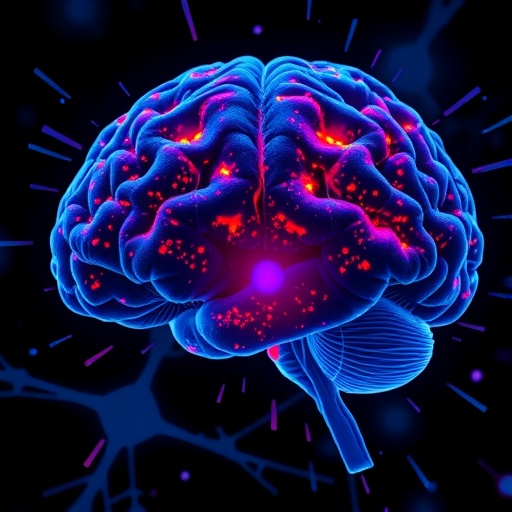In a groundbreaking study poised to reshape our understanding of tumor biology, researchers at the Sylvester Comprehensive Cancer Center, part of the University of Miami Miller School of Medicine, have unveiled a novel mechanism that governs the adaptability—or plasticity—of glioblastoma cells. This advancement offers critical insights into why these aggressive brain tumors stubbornly resist treatment and recur with lethal tenacity. By employing state-of-the-art spatial transcriptomics, the team decoded how the physical arrangement of tumor cells influences their behavior, revealing that glioblastoma cells that scatter individually within the tumor microenvironment become more versatile and dangerous compared to their counterparts clustered tightly together.
Glioblastoma remains one of the most devastating cancers diagnosed in adults, notorious for its rapid progression and limited survival rates, averaging just over a year post-diagnosis. Traditional therapies, including surgery, chemotherapy, and radiation, often fail to prevent tumor regrowth, as these tumors develop resistance that baffles oncologists worldwide. The study led by Dr. Anna Lasorella and Dr. Antonio Iavarone has, for the first time, connected the dots between tumor cell spatial dynamics and cancer plasticity, providing an integrated explanation for this clinical enigma.
Using the revolutionary CosMx Spatial Molecular Imager platform, researchers achieved unprecedented resolution by profiling gene expression at the single-cell level while preserving spatial context within glioblastoma tumors. This technology made it possible to not only identify distinct tumor cell subtypes, as previous work had done, but also to map their precise locations and interactions within the tumor matrix. The discovery that cells forming dense, homotypic clusters exhibit less plasticity than those dispersed among heterogeneous cell populations challenges prior assumptions that cell proximity has purely proliferative or metabolic implications.
Further molecular analyses unveiled key differences in gene expression between clustered and dispersed cells. Clustered glioblastoma cells express adhesion molecules on their surface, promoting tight intercellular connections that restrict their phenotypic flexibility. In contrast, dispersed cells lack or downregulate these adhesion proteins, which appears to grant them the ability to shift more readily between cellular states. This plasticity empowers them to survive hostile conditions, evade therapeutic assault, and contribute to tumor heterogeneity, underpinning resistance and recurrence mechanisms.
Strikingly, these principles were not confined to glioblastoma alone. Validation studies conducted on breast cancer samples demonstrated a parallel pattern: solitary, dispersed cancer cells harbor greater plasticity than their clustered counterparts. As plasticity is a well-known driver of metastasis—cancer’s deadly spread to distant organs—this finding raises the possibility of a universal principle in solid tumor biology. While glioblastoma rarely metastasizes outside the brain, understanding the plasticity phenomenon may illuminate pathways regulating tumor spread and aggressiveness in a spectrum of cancers.
One tantalizing implication of this work concerns standard cancer therapies. Chemotherapy and radiation, while aiming to eradicate tumor mass, may inadvertently disrupt these protective clusters and release cells into a dispersed state, paradoxically enhancing the population of the more plastic and aggressive tumor cells. This hypothesis highlights the complexity of treatment responses and urges reconsideration of how localized tumors should be managed to minimize inducing cellular dispersion and plasticity.
Dr. Iavarone emphasized that this research uncovers a regulatory axis of cancer cell plasticity that had eluded scientists for decades. Prior to this study, explanations for how cancer cells gained phenotypic versatility lacked a unifying framework. The elucidation of spatial homotypic clustering as a restraining force on plasticity transforms our conceptual approach and opens new therapeutic possibilities aimed at maintaining or restoring cellular adhesion to limit tumor evolution and spread.
The research team is actively investigating whether pharmacological agents can be designed to bolster cell adhesion in tumors, thereby confining cancer cells to less plastic, clustered states. Early preclinical models have demonstrated that disrupting these adhesion proteins increases the number of dispersed, plastic cells. However, reversing this effect to promote clustering selectively may prove more challenging yet holds the promise of mitigating tumor aggressiveness from within.
Moreover, the researchers are pursuing the identification of molecular drivers leading to adhesion loss in these dispersed cells. If proteins that actively dismantle cellular cohesion are discovered and validated as druggable targets, they could usher in a new class of precision therapies designed to counteract cancer cell plasticity, extending patient survival and combating resistance.
This study marks a watershed moment in cancer research, fusing cutting-edge transcriptional profiling with spatial cell biology to decode complex tumor ecosystems. By revealing how micro-scale cell arrangements dictate malignant potential, the findings enrich fundamental cancer biology and set the stage for transformative clinical interventions that recognize tumors not merely as collections of rogue cells but as dynamic communities governed by spatial logic.
Ultimately, the insights gleaned from glioblastoma, a cancer typifying therapeutic intractability, might resonate across oncology, providing a blueprint to restrict tumor cells’ ability to adapt and resist. This could translate into novel combination strategies that integrate adhesion-targeting agents with current treatments to forestall tumor progression, reduce relapse, and improve long-term outcomes.
As Dr. Lasorella succinctly puts it, “If we can better understand this mechanism, we hope to one day be able to maintain clustered cells in a less plastic state or even reverse dispersal, transforming a tumor’s behavior towards one more amenable to treatment.” The convergence of spatial transcriptomics and molecular oncology has illuminated a critical barrier to effective cancer therapy—and now offers hope for dismantling it.
Subject of Research: Glioblastoma cell plasticity and spatial clustering in solid tumors
Article Title: Restraint of cancer cell plasticity by spatial homotypic clustering
News Publication Date: 18-Sep-2025
Web References: http://dx.doi.org/10.1016/j.ccell.2025.08.009
Image Credits: Photo by Sylvester Comprehensive Cancer Center
Keywords: Glioblastoma cells, Cancer cells, Breast cancer cells, Cell biology




